Reviews
Josef von Sternberg
USA, 1934
Credits
Review by Matt Bailey
Posted on 23 August 2010
Source Universal France DVD
Categories von Sternberg & Dietrich
Of the seven films Josef von Sternberg made with Marlene Dietrich, indeed of all the films he made in the studio system, The Scarlet Empress might just be the purest, most unadulterated distillation of his many obsessions and talents. Von Sternberg made the film at a time of executive upheaval at Paramount, which meant that B.P. Schulberg, Paramount’s meddlesome head of West Coast production, was no longer around, and von Sternberg mostly was left to his own devices. Though he had always taken a large role in writing, producing, and photographing his own films (as well as in the creation of Dietrich as a credible actress and as a sex goddess), von Sternberg’s autobiography, Fun in a Chinese Laundry, has him taking credit as well for the sets and costumes of The Scarlet Empress and even for conducting the orchestra during the recording of the score (which, naturally, he takes some credit for composing). While the reality is surely that he had strong opinions on and final approval of all aspects of the film’s production but left the actual heavy lifting to a talented crew (including set designer Hans Dreier, costume designer Travis Banton, and sculptor Peter Ballbusch—all uncredited), The Scarlet Empress probably comes as close to representing the vision of a single person more than any studio film of Hollywood’s classic era.
The Scarlet Empress is full-to-bursting with foreground filigree and monstrous gargoyle carvings, so overstuffed with indulgent, idiosyncratic performances using every accent from Budapest to Brooklyn, the film is like a flower so strange and so beautiful it could only have germinated in the hothouse environment of a major Hollywood studio. By the time the first twenty minutes have elapsed, the audience has been served bare breasts (in tasteful soft focus), scenes of torture and beheadings, a gag involving a wig, and a mother-in-law joke; all this even before the first sight of Sam Jaffe, who plays Grand Duke Peter as a grotesquely grinning idiot leering from behind the Empress’ skirts. Unlike the later robust yet restrained “composed” films of Powell and Pressburger and Sergei Eisenstein that were undoubtedly influenced by it, The Scarlet Empress is altogether just too much. It is beyond unrestrained; it’s positively unhinged. The film is based on actual, historical personages, and there is enough historical specificity to keep the film just out of the realm of pure invention, but only just. Von Sternberg, using history as a backdrop against which to project his florid fantasies, is wholly unconcerned with accuracy. The director rightly deemed the film “a relentless excursion into style,” and we might as well be watching a psychic recording of a von Sternberg fever dream than anything resembling a historically instructive costume drama.
The first hour of the film is consumed with the quest of Dietrich’s Catherine to produce an heir, and the plot (what little there is of it) unfolds at a languorous pace while Dietrich puts forth a portrayal of Catherine (née Princess Sophia Fredrica) as a wide-eyed innocent. It’s meant in the context of the story to be sincere and to provide contrast to the domineering ruler she becomes in the second half, but it’s so obviously an arch put-on. No audience in 1934 and no audience today would believe Dietrich as a virgin in petticoats and curls, and Dietrich and Sternberg knew it, so it is played to the balcony. Once Catherine gives in to the overtures of a guard standing watch outside her window (and, conveniently, produces that heir she needed), her character changes abruptly and we get the imperious yet smirkingly carnal Dietrich character we expect. To put it in terms of her contemporary box office rivals, she goes from Shirley Temple to Mae West in the span of a single cut. Though the film gains some narrative momentum after this point, the plot and pacing are still entirely subservient to the style, but what style!
Von Sternberg, when he isn’t filling the screen with tight close-ups of Dietrich’s porcelain face with those huge eyes, those famous cheekbones, and that always-perfect shadow under her nose, makes each frame a compositional tableau in depth, filling the on-screen space not just from top to bottom and from side to side, but also from front to back. Though the opening credits boast of “a supporting cast of 1000 players,” most of them appear only in a short clip of a crowd filling a public square purloined from Ernst Lubitsch’s The Patriot that von Sternberg weaves into his film four or five times. Yet there are enough extras to fill the cavernous sets of the film from the very foreground to the furthest background for several crowd scenes. These include Catherine’s wedding to the “royal half-wit” (in which there are at least three candles for every cast member, probably not a good idea in a cathedral draped with tulle) and a convincing palace coup that includes the memorable final scene of Catherine, outfitted in a tight white military uniform blazing with braid and buttons and topped with an enormous white fur hat, leading a squadron on horseback up the stairs of the palace and installing herself on the throne of the empire to the alternating strains of Tchaikovsky’s “1812 Overture” and Wagner’s “Ride of the Valkyries” (as if one bombastic, anachronistic theme is not quite enough for the moment).
It’s kind of funny to think that as revered as Josef von Sternberg’s film collaborations with Marlene Dietrich are now, and as successful with critics and audiences as the first several of these collaborations were upon their release, that The Scarlet Empress was not even 1934’s most financially successful film about Catherine the Great starring a blonde German emigrant directed by a Jewish Austro-Hungarian aesthete. That distinction belongs to The Rise of Catherine the Great, a film produced by Alexander Korda, directed by Paul Czinner, and starring Czinner’s wife, Elisabeth Bergner, and Douglas Fairbanks, Jr. While both films feature equally lavish sets and glittering costumes, Czinner’s film is utterly conventional, divided neatly in halves: an insipid romantic comedy opening (complete with a “meet cute” between the leads) and a tedious, politically-trimmed marital drama ending. Bergner may have had talent—she was an popular theater actress in her youth in Germany and nominated for an Oscar for her and Czinner’s follow-up to Catherine the Great, _ Escape Me Never_—but there is not much evidence of it in this film. That is partly due to the mechanics of the plot that require her to do little more than pout or throw squeaky-voiced hissy fits, but also due to the fact that she lacked both the sensuality and chilly, commanding presence required for the role that Dietrich had in abundance. As Catherine, Bergner - with her tight blonde curls, pursed lips, and worried face - looks less like the Empress of All the Russias than she does Harpo Marx. Curiously, both films elevate the supporting part of the Empress Dowager, Elizabeth, into the plum role. Flora Robson, in Czinner’s film, plays her as a snippy, conniving despot, cruelest to those who have any affection for her. Louise Dresser, in von Sternberg’s film, does not stray too far from this characterization, but her Indiana-by-way-of-Broadway accent and matter-of-fact dismissals of her inferiors makes her seem less like a preening empress and more like your least favorite aunt. Both women seem to have a great time with the role, stomping around the sets and shouting orders, so it’s fortunate for the lead actresses in each film that history requires Elizabeth to die halfway through the story.
The final result of any comparison of the two films, though, is bound to be an appreciation of what a bizarre, yet unique, piece of art von Sternberg’s film is. For putting every dollar of the budget up on screen in the service of beauty and for sheer outrageous glamour and style, von Sternberg and Dietrich had few rivals in their day and even fewer (if any) today. The original, unfavorable New York Times review of The Scarlet Empress stated that the film is a “ponderous, strangely beautiful, lengthy and frequently wearying production, [and] strictly not a dramatic photoplay at all, but a succession of overelaborated scenes, dramatized emotional moods and gaudily plotted visual excitements.” And they said that like it’s a bad thing.
More von Sternberg & Dietrich
-
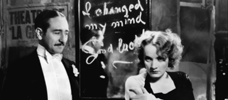
Morocco
1930 -
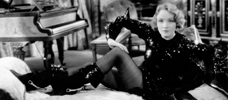
Dishonored
1931 -
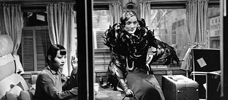
Shanghai Express
1932 -
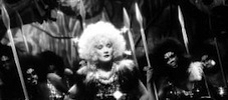
Blonde Venus
1932 -
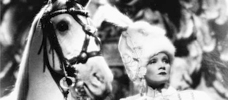
The Scarlet Empress
1934 -
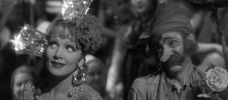
The Devil is a Woman
1935
We don’t do comments anymore, but you may contact us here or find us on Twitter or Facebook.



